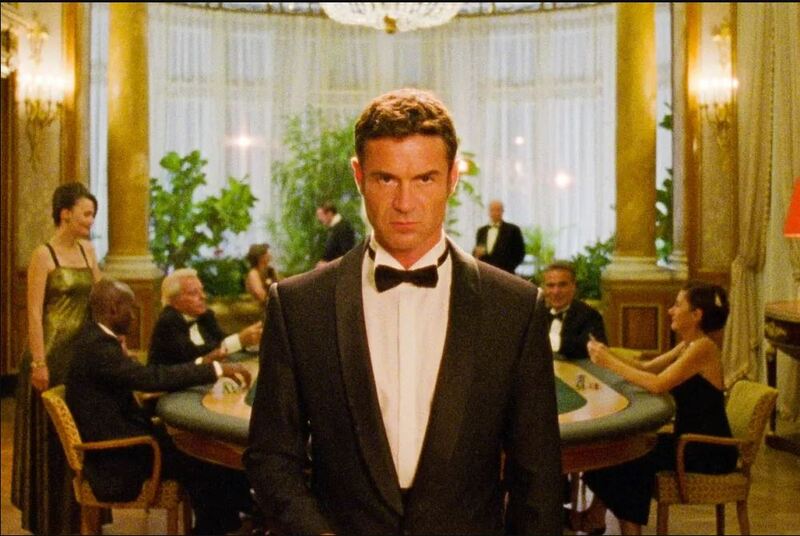Berlinale 2025 Review: REFLECTION IN A DEAD DIAMOND Dissects the Eurospy Genre
Hélène Cattet and Bruno Forzani continue their deconstruction of genre cinema in a visual rollercoaster, consisting of formal pyrotechnics and a disorienting narrative.

The genre-bending duo of Hélène Cattet and Bruno Forzani continue their exploration of self-reflexive genre filmmaking with Reflection in a Dead Diamond, a film that merges the aesthetics of Eurospy cinema with the existential unease and the sadism of exploitation fare.
The film revolves around John D, a spy whose story unfolds across multiple timelines overlapping present with past memories. In the most recent, an aging John D, portrayed by Fabio Testi, resides in a luxury hotel on the Côte d'Azur. A chance encounter with a neighbor sets off a hallucinatory spiral of paranoia and nostalgia. When the enigmatic woman vanishes, John D is forced to confront both his loosening grip on reality and the ghosts of his past.
Cattet and Forzani are often linked to the neo-giallo movement, though their films function less as homages than as ongoing interrogations of the genre’s visual and narrative form. Their debut feature, Amer, distilled giallo aesthetics into a near-wordless study of perception and desire, while The Strange Color of Your Body’s Tears expanded this approach into a fragmented, almost cubist structure. With Let the Corpses Tan, an adaptation of a crime novel, they shifted from the baroque interiors of giallo to the sun-bleached brutality of Italian crime and western cinema while maintaining their signature hyper-stylized imagery.
They extend their experimentation in form to the Eurospy film, a genre that, like giallo, emerged in dialogue with dominant cinematic trends of its time in Reflection in a Dead Diamond. The film engages in cycles of deconstruction and reconstruction, pushing its stylistic framework toward a hallucinatory interplay of fractured memory, overlapping timelines and shifting realities and odd fantasies. As the film unfolds, these disorienting layers extend beyond the cinematic form, incorporating additional media to reach a meta-textual and self-reflective dimension.
The film constructs its disorienting non-linear story through a collision of cinematic textures, blurring the boundaries between timelines and memory in the vein of the trope of unreliable narrator though Reflection in a Dead Diamond's protagonist appears more deranged than unreliable.
Fabio Testi’s casting as the aging John D serves not only as a nod to his career, spanning both arthouse and exploitation cinema, but also as a reflection of the film’s preoccupation with identity’s gradual erosion. Opposite him, Yannick Renier portrays the younger John D, reinforcing the film’s fascination with doppelgängers and mirroring across timelines and fantasies.
The film visually incorporates motifs from Op Art, a movement rooted in optical illusion, heightening its themes of deception and shifting reality. This approach aligns with Cattet and Forzani’s prior use of Art Nouveau in The Strange Color of Your Body’s Tears and New Realism in Let the Corpses Tan, but here, an additional layer emerges through the influence of pulp comics referencing Diabolik. This stylistic interplay fractures the film’s perceived reality further, undermining the protagonist’s sense of self and intensifying his internal unraveling.
Cattet and Forzani situate their protagonist in a liminal space where past allegiances and betrayals dissolve into abstraction. The film unfolds through a series of layered, intersecting realities in which multiple narrative strata exist simultaneously. Each iteration reframes the audience’s perception of events, forcing a continual reassessment of the film’s mercurial plot.
Initially, Reflection in a Dead Diamond unfolds at a deliberate pace, mirroring the title’s meditative undertones, until John D’s dormant instincts resurface, propelling him into one more adventure of chasing chimeras of his former life. As the film accelerates, Cattet and Forzani intensify its momentum, shifting rapidly between chronology, shifting alliances, surreal visions, and graphic murders.
Though structured around the familiar framework of the Eurospy film, the directors dismantle its conventions, transforming the genre’s escapist fantasies into something more unsettling. What begins as a variation on the James Bond myth in a more sadistic makeover, steeped in retro aesthetics, is gradually overtaken by a barrage of formal experimentation, as narrative coherence gives way to an overwhelming sensory experience.
As the film progresses, form overtakes substance, pushing the trope of the unreliable narrator to an extreme where fragmented storylines spiral into near-visual delirium. While meticulously constructed for sensory immersion, the film’s relentless visual pyrotechnics, kaleidoscopic structure witht hallucinatory effects may alienate viewers seeking a more structured storytelling, as its sometimes self-serving visual rolercoaster takes over story. At times, the sheer intensity of its imagery overwhelms, leading to a sense of exhaustion under the weight of its own excess as the plot vanishes.
Ultimately, Reflection in a Dead Diamond is less concerned with espionage than with perception. The film functions as both an homage to and a deconstruction of genre, layering its self-reflexive and meta-textual dimensions to examine the fluidity of identity, memory, and sanity.
The film enjoyed its world premiere at the 2025 Berlinale.









